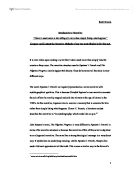The story of the amphibious bird that exists on land and water oft mentioned by Al-Hasan Ibn Al-Wazzan is analogous to Al-Wazzan himself. The bird can exist in either land or water, whichever habitat is best at the present time. Like the bird, Al-Wazzan traveled throughout Europe aligning himself with the group that best served him at that time, yet never fully identifying with a specific group. In doing so, he finds himself existing paradoxically between two converging worlds, a world of familiarity and a world of the new and different. For instance, despite being born in Granada, Al-Wazzan does not identify himself as a native of Granada. Instead he considers himself a diplomat of Fez and a devout Muslim. However, after the death of Pope Leo X, Al-Wazzan does not choose to go on a boat back to Fez and instead remains in Italy. Yet he does not consider himself fully immersed in the Italian culture, because their pig-eating habits contradict Muslim dietary laws.
His nation-less stance can best exemplified when he does not take the opportunity to sneak on a boat back to Fez after the death of the pope. It is unknown to scholars as to why Al-Wazzan elected to remain in Italy, however the journey of the bird could explain Al-Wazzan’s reasoning behind his decision. The bird does not limit itself to land or sea because it inhabits the place where the best opportunities are present. Likewise, Al-Wazzan does not allow himself to be categorized, but rather undulates between national identities, African as opposed to European. He subconsciously searches for excuses that allow him to participate in the fascinating, novel European lifestyle. In fact, he is so drawn to the new intriguing European customs that he chooses to remain in European Italy, rather than return African Fez.
During the 16th century, the Wars of Religion broke out. There was little tolerance among the Muslims and the Christians. At that time, the Europeans’ acceptance of Al-Wazzan and their symbiotic existence was unusual, but they were so mystified by each other’s differences that they were hesitant to let each other go. The Europeans ask Al-Wazzan a series of basic questions in an attempt to understand North African relationship dynamics, “Do women wear veils? Can men marry more than one woman?” At this, Al-Wazzan “tricks” the Europeans into trusting him by revealing facts about North Africa. The Europeans’ curiosity about North African paired with Al-Wazzan’s “trickery” allowed the two groups to tolerate each other.
Al-Wazzan is identified as a trickster—manipulating the Europeans into respecting and accepting him (Davis 112). However, it can be argued that Al-Wazzan was the one who was in fact being tricked. Al-Wazzan tricked himself. He tricked himself into believing he lived for the greater fundamental purpose of gaining understanding and acceptance of a Christian community in order to bring about a Christian acceptance of Islam. During his stay in Europe, Al-Wazzan meets the tricky Jewish man who taught the European Christians Hebrew under the guise of helping them better understand the Bible (Davis 196). When the Jewish man explains to Al-Wazzan that he had helped Christians gain an appreciation for Judaism, Al-Wazzan convinces himself that he is following a similar path.
On the contrary, Al-Wazzan fails to the European community to develop his own similar understanding. Al-Wazzan wrote his books with not only North Africans in mind. He equally thought of Europeans. Instead of tricking the Italian community into sensing a sense of kinship with Islam, he tricked himself into the grandiose idea that he had made an impression for anyone other than himself. Al-Wazzan did not represent the nation of Islam like he envisioned. The Europeans world readily accepted the Christian-convert Al-Wazzan as they continued their war against Islam. In the end, he created a positive image for only himself.
Though Al-Wazzan felt a strong, conscious connection to Islam, the argument can be made that he did not make a real attempt to hold onto his Islamic beliefs. When Al-Wazzan converted to Christianity, he offered little resistance. He justified his baptism with the Qur’an by finding a passage that justified such transgressions if in an inopportune situation. However, Al-Wazzan refuted the Qur’an’s generally accepted method of jihad. He did not believe jihad had to result in physical conflict, but instead thought that he only to make an effort to have polytheists and non-believers convert to Islam. In both instances, he interprets the holy book of the Qur’an in order to allow him to continue his scholarly pursuits in the most opportune fashion. He refuses to give up any pleasure. He does nothing that would make his travels more difficult in order to adhere to religious practices, but justifies his practices using the Qur’an (Davis 189). He tricks himself into believing he has a connection to Islam, but abandons Islam the moment he enters European society. His conscious mind follows Islam. His unconscious mind follows the present world around him. His masters viewed him as a Christian, his friends as a prisoner, and he viewed himself as an Islamic scholar. In the pre-technology world where impression was everything, every man saw in people the qualities they wished to see. In Al-Wazzan’s case, he put up a veil in order to better network through society.
Although, Al-Wazzan is known as a “trickster,” tricking those around him into accepting him as part of their group, and tricking himself into accepting differences. His “trickery” reveals a motif still prevalent in society today, the coexistence and acceptance of different groups of people in one world, being tolerant and learning about differences. Trickery in this sense isn’t so much of a malicious trickery, so much as a move to avoid conflict. Perhaps, at times, we must become the amphibious bird in unfamiliar situations and adapt.








